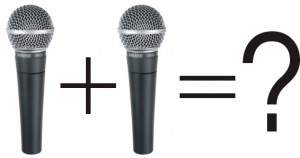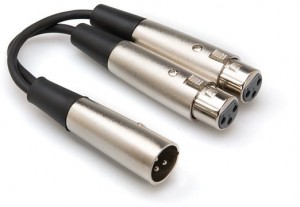Summing Two Mic Signals

One of my most popular articles has been The Mono Summing Cable that No One Makes. I’ve been contacted by more readers regarding that article than probably any other that I’ve written. That article details why it’s a bad idea to use a regular Y-cable or TRS-to-TS cable to sum two (usually stereo left & right) line-level signals to mono by simply shorting the outputs together. It’s ok to use such a cable for SPLITTING a signal, but not for COMBINING or SUMMING two signals. That being said, it can work ok on some devices, but on others it can cause distortion, weird phasing artifacts, and possibly even damage the outputs of your gear. However, combining the outputs of two dynamic microphones is a different story, and in some applications it’s ok to do so with a regular XLR Y-cable, as we will soon see.
Case in point: I recently needed to host a series of rehearsals with a rather large band at my studio. This group included 6 singers/singing musicians, acoustic guitar, electric guitar, bass, keyboard, and synth pads played from a smart phone. I also have a rather large drum kit set up in the studio with two kick drums, snare, two high toms, and two floor toms (7 drums in all). Now here’s the fun part: I use a set of wired in-ear monitors, so EVERYTHING had to be miked for me to hear it properly, even if some of it (e.g., electric guitar, bass, & drums) wouldn’t necessarily need to be run through the monitor wedges for the other members of the band. I also planned to make a multi-track recording of the rehearsals onto my laptop using Samplitude and my Behringer XR18 digital mixer, so again, everything had to be miked.
The XR18 has 16 XLR mic inputs plus a stereo line input, so my inputs looked something like this:
- Vocal 1
- Vocal 2
- Vocal 3
- Vocal 4
- Vocal 5
- Vocal 6
- Acoustic Gtr
- Electric Gtr
- Keyboard
- Bass
- Kick
- Snare
- High Toms
- Floor Toms
- Left Overhead
- Right Overhead
- Aux/Line In: Pads
As you can see, my inputs were maxed out, I only had six channels for the drums, and I really could have used a few more. With the available inputs, I was going to be forced to share one mic between the two Toms and another mic between the two Floor Toms. Due to the less-than-optimal positioning, I would need to turn up the gain more on those mics, causing them to pick up more spill/bleed from the rest of the kit and more room noise than normal. That extra bleed and noise would not sound good in my in-ear monitors. Also, since it’s impossible to share a single mic between two kick drums, this meant my second kick drum wouldn’t be miked at all. The style of music that I was playing with this group didn’t call for a lot of double kick action, but it would be nice to have that second kick drum miked, even if just for the occasional fill.
Since it was totally impractical to upgrade to a larger mixer with more inputs (something like the Soundcraft UI24R) for this short series of rehearsals, I decided to do some reading up on whether it’s ok to sum two mic signals together to a single input using a regular XLR Y-cable. As with anything related to pro audio, there’s a lot of conflicting information and opinions online. Some forum posters commented that they’ve “…done this for years and it always worked just fine”. Others responded that “just because you CAN do something doesn’t mean you SHOULD”. Still others responded that “you need to buy or build a special mic combiner for this to work properly without causing any problems”. Still others cited the same “Why Not Wye” article that I cited in my earlier article, The Mono Summing Cable That No One Makes. Finally, I came across a post on the Harmony Central forum that I felt did a good job of answering the questions. You can read that post by clicking here.
After all of the reading and attempting to separate the good information from the bad, a few key points emerged:
• Summing the signals from two DYNAMIC mics of the same make/model is generally ok. The impedance loading of the mics may affect the tone of each signal slightly, but probably not in a significant way.
• A mic combiner is usually not needed for dynamic mics of the same make/model. However, these devices may be useful if you’re using mics that are not the same make/model, you’re using them on vastly different sources, or you’re using condenser mics requiring phantom power.
• Summing the signals from two mics on the same source (e.g. miking the top and bottom of the same snare drum or tom) or sources in close proximity to one another can cause phase cancellation, which is a bad thing. But that can usually be fixed by flipping the phase of one of the mics using an XLR phase reverse barrel.
After my research was complete, I purchased 3 XLR Y-cables and connected them up. So my (revised) inputs for channels 11, 13, & 14 now looked like this:
11: Kick 1 + Kick 2 (both Audio Technica ATM25’s)
13: Tom 1 + Tom 2 (both Sennheiser e604’s)
14: Floor Tom 1 + Floor Tom 2 (both Sennheiser e604’s)
I donned my in-ear monitors, reset the input levels for those channels, and everything sounded great. All of the drums sounded very full with plenty of low end, so I didn’t even bother flipping the phase of any of the mics. So if you need a few extra mic inputs in a pinch, and you’re using the same make/model of dynamic mic, give this a try. Keep in mind that ideally, you should be using two dynamic mics of the same make and model. And the sources that you’re miking with them should be relatively the same in loudness, since you won’t have separate volume control for each mic (although even that could be tweaked slightly by moving the mic closer or farther away from the source). In any case, contrary to what you may have read or been told, this can work just fine for certain applications.
Products referenced in this article:
HOSA XLR Y-cable
CBI XLR Y-cable
ART Splitcom Pro Mic Combiner
Behringer XR18 Digital Mixer
Audio Technica ATM25 Kick Mic
Sennheiser e604 Tom Mic
In-Ear Monitor Systems
Stage Monitor Speakers
HOSA Phase Reverse Barrel
 September 24, 2019
|
Posted by Jon (admin)
September 24, 2019
|
Posted by Jon (admin)

 Categories:
Categories:  Tags:
Tags: 